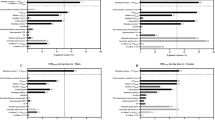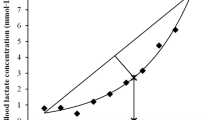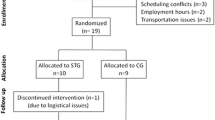Abstract
This study investigated the effects of the neuromuscular and force–velocity characteristics in distance running performance and running economy. Eighteen well-trained male distance runners performed five different tests: 20 m maximal sprint, running economy at the velocity of 4.28 m s−1, 5 km time trial, maximal anaerobic running test (MART), and a treadmill test to determine VO2max. The AEMG ratio was calculated by the sum average EMG (AEMG) of the five lower extremity muscles during the 5 km divided by the sum AEMG of the same muscles during the maximal 20 m sprinting. The runners’ capacity to produce power above VO2max (MART VO2gain) was calculated by subtracting VO2max from the oxygen demand of the maximal velocity in the MART (V MART). Velocity of 5 km (V 5K) correlated with V MART (r=0.77, p<0.001) and VO2max (r=0.49, p<0.05). Multiple linear regression analysis showed that MART VO2gain and VO2max explained 73% of the variation in V 5K. A significant relationship also existed between running economy and MART VO2gain (r=0.73, p<0.01). A significant correlation existed between V 5K and AEMG ratio during the ground contact phase at the 3 km (r=0.60, p<0.05) suggesting that neural input may affect distance running performance. The results of the present study support the idea that distance running performance and running economy are related to neuromuscular capacity to produce force and that the V MART can be used as a determinant of distance-running performance.




Similar content being viewed by others
References
Ansley L, Robson P, St Clair Gibson A, Noakes TD (2004a) Anticipatory pacing strategies during supramaximal exercise lasting longer than 30 s. Med Sci Sports Exerc 36:309–314
Ansley L, Schabort E, St Clair Gibson A, Lambert MI, Noakes TD (2004b) Regulation of pacing strategies during successive 4-km time trials. Med Sci Sports Exerc 36:1819–1825
Bassett DR, Howley ET (1997) Maximal oxygen uptake: classical versus contemporary viewpoints. Med Sci Sports Exerc 29:591–603
Bassett DR, Howley ET (2000) Limiting factors for maximum oxygen uptake and determinants of endurance performance. Med Sci Sports Exerc 32:70–84
Conley DL, Krahenbuhl GS (1980) Running economy and distance running performance of highly trained athletes. Med Sci Sports Exerc 12:357–360
Costill DL, Thomason H, Roberts E (1973) Fractional utilization of the aerobic capacity during distance running. Med Sci Sports Exerc 5:248–252
Creer AR, Ricard MD, Conlee RK, Hoyt GL, Parcell AC (2004) Neural, metabolic and performance adaptations to four weeks of high intensity sprint-interval training in trained cyclists. Int J Sports Med 25:92–98
Davies CTM, Thompson MW (1979) Aerobic performance of female marathon and male ultramarathon athletes. Eur J Appl Physiol 41:233–245
Di Prampero PE (1986) The energy cost of human locomotion on land and water. Int J Sports Med 7:55–72
Di Prampero PE (2003) Factors limiting maximal performance in humans. Eur J Appl Physiol 90:420–429
Durnin JV, Womersley J (1974) Body fat assessed from total body density and its estimation from skinfold thickness: measurements on 481 men and women aged from 16 to 72 years. Br J Nutr 32:77–97
Farrell PA, Wilmore JH, Coyle EF, Billing JE, Costill DL (1978) Plasma lactate accumulation and distance running performance. Med Sci Sports 11:338–344
Foster C, Costill DL, Daniels JT, Fink WJ (1978) Skeletal muscle enzyme activity, fibre composition and VO2max in relation to distance running performance. Eur J Appl Physiol 39:73–80
Hill AV, Lupton H (1923) Muscular exercise, lactic acid and the supply and utilization of oxygen. Q J Med 16:135–171
Johnston RE, Quinn TJ, Kertzer R, Vroman NB (1997) Strength training in female distance runners: impact on running economy. J Strength Cond Res 11:224–229
Joyner MJ (1991) Modeling: optimal marathon performance on the basis of physiological factors. J Appl Physiol 70:683–687
Kayser B (2003) Exercise starts and ends in the brain. Eur J Appl Physiol 90:411–419
Lacour JR, Padilla-Magunacelaya S, Barthélémy JC, Dormois D (1990) The energetics of middle-distance running. Eur J Appl Physiol 60:38–43
Lambert EV, St Clair Gibson A, Noakes TD (2005) Complex systems model of fatigue: integrative homeostatic control of peripheral physiological systems during exercise in humans. Br J Sports Med 39:52–62
Londeree BR (1986) The use of laboratory test results with long distance runners. Sports Med 3:201–213
Maxwell NS, Nimmo MA (1994) Anaerobic capacity in humans: validation of a maximal anaerobic running test against the maximal accumulated oxygen deficit. Clin Sci (Suppl Biochem Exerc) 87:15–16
Morgan DW, Martin PE, Krahenbuhl GS (1989) Factors affecting running economy. Sports Med 7:310–330
Noakes TD (2000) Physiological models to understand exercise fatigue and the adaptations that predict or enhance athletic performance. Scan J Med Sci Sports 10:123–145
Noakes TD, Peltonen JE, Rusko HK (2001) Evidence that a central governor regulates exercise performance during acute hypoxia and hyperoxia. J Exp Biol 204:3225–3234
Noakes TD, St Clair Gibson A (2004) Logical limitations to the catastrophe models of fatigue during exercise in humans. Br J Sports Med 38:648–649
Nummela A, Mero A, Stray-Gundersen J, Rusko H (1996) Important determinants of anaerobic running performance in male athletes and non-athletes. Int J Sports Med 17(Suppl 2):S91–S96
Paavolainen L, Häkkinen K, Hämäläinen I, Nummela A, Rusko H (1999a) Explosive strength-training improves 5-km running time by improving running economy and muscle power. J Appl Physiol 86:1527–1533
Paavolainen LM, Nummela AT, Rusko HK (1999b) Neuromuscular characteristics and muscle power as determinants of 5-km running performance. Med Sci Sports Exerc 31:124–130
Paavolainen L, Nummela A, Rusko K, Häkkinen K (1999c) Neuromuscular characteristics and fatigue during 10-km running. Int J Sports Med 20:1–6
Paavolainen LM, Nummela AT, Rusko HK (2000) Muscle power factors and VO2max as determinants of horizontal and uphill running performance. Scand J Sci Sports 10:286–291
Rusko H, Nummela A (1996) Measurement of maximal and submaximal anaerobic power. Int J Sports Med 17(Suppl 2):S89–S130
Rusko H, Nummela A, Mero A (1993) A new method for the evaluation of anaerobic running power in athletes. Eur J Appl Physiol 66:97–101
Scrimgeour AG, Noakes TD, Adams B, Myburgh KH (1986) The influence of weekly training distance on fractional utilization of maximum aerobic capacity in marathon and ultramarathon runners. Eur J Appl Physiol 55:202–209
St Clair Gibson A, Noakes TD (2004) Evidence for complex system integration and dynamic neural regulation of skeletal muscle recruitment during exercise in humans. Br J Sports Med 38:797–806
Viitasalo JT, Luhtanen P, Mononen HV, Norvapalo K, Paavolainen L, Salonen M (1997) Photocell contact mat: a new instrument to measure contact and flight times in running. J Appl Biomech 13:254–266
Acknowledgements
The authors wish to thank Mr Matti Salonen for his assistance in data collection and technical support. This research was supported by the grant from the Finnish Ministry of Education. The research of the MRC/UCT Research Unit for Exercise Science and Sports Medicine is funded by the Harry Crossley and Nellie Atkinson Staff Research Funds of the University of Cape Town, the Medical Research Council, the National Research Foundation through the THRIP initiative and Discovery Health.
Author information
Authors and Affiliations
Corresponding author
Rights and permissions
About this article
Cite this article
Nummela, A.T., Paavolainen, L.M., Sharwood, K.A. et al. Neuromuscular factors determining 5 km running performance and running economy in well-trained athletes. Eur J Appl Physiol 97, 1–8 (2006). https://doi.org/10.1007/s00421-006-0147-3
Accepted:
Published:
Issue Date:
DOI: https://doi.org/10.1007/s00421-006-0147-3




